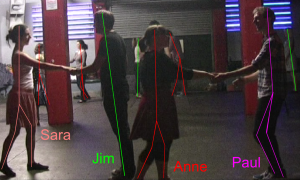Dances – like everyday physical interactions – are built from a constrained repertoire of possible bodily movements. It’s a useful activity to study because the performers, learners and audiences of dance can be observed managing the production and evaluation of movements specifically as dance.

This presents participants with interesting and observable challenges. How do they move from dancing to non-dancing, and how do they show each other that they are making these switches? How do audiences decide when and how to applaud, and how do they demonstrate their sensitivity to particular parameters and relevant moments of evaluation during a dance? And what is distinctive about bodily movement that makes it function as dance?
This research forms part of an overall exploration of social/aesthetic practices and activities including learning, teaching, and performing dance, and body-oriented psychotherapies that involve people in doing and evaluating of dance movements. For example, Dirk vom Lehn and I have collected a large amount of video showing how novice partner dancers learn during workshops, and have been analyzing these alongside video of professional improvised dance performances.
Publications
- Albert, S., & vom Lehn, D. (2023). Non-lexical vocalizations help novices learn joint embodied actions. Language & Communication, 88, 1–13. https://doi.org/10.1016/j.langcom.2022.10.001
- Albert, S. (2015) Rhythmical coordination of performers and audience in partner dance: delineating improvised and choreographed interaction. Etnografia e Ricerca Qualitativa 3/2015, 399-428. doi: 10.3240/81723
Presentations
- Albert, S., & vom Lehn, D. (2018, July). Vocalizations as evaluative assessments in a novice partner dance workshop. International Conference on Conversation Analysis 2018, Loughborough, UK.
- Albert, S., & vom Lehn, D. (2018, August). The First Step is Always the Hardest: Rhythm and Methods of Mutual Coordination between Novice Dancers. 113th American Sociological Association Annual Meeting, Philadelphia, PA.
- vom Lehn, D. & Albert, S. (2018, July). Producing ‘joint action’ in Lindy Hop Dance Lessons. Annual Meeting of the Society for the Study of Symbolic Interaction 2018, Lancaster, UK.
- Albert, S. (2017, September). Assessments in the service of rhythmical closings. Presented at the 7th Language and Social Interaction (LANSI) Working Group Meeting, New York.
- Albert, S. & Vom Lehn, D. (2017, July). Beginning to dance: methods of mutual coordination between novice dancers. Presented at the 7th Joint Action Meeting, London, UK.
- Albert, S. (2015, November). Joint improvisation, choreography and social action in a musical partner dance performance. Paper presented at The Science of Joint Improvisation Meeting, CNRS, Paris.
- Albert, S. (2015, June). Dancing through time and space. Paper presented at Revisiting Participation: Language and Bodies in Interaction, Basel.
- Albert, S. (2014, June). Interactional resources and their use in learning the Lindy Hop. Paper presented at the 6th Ethnography and Qualitative Research Conference, Bergamo.
- Albert, S. (2014, June). Interactional choreography. Paper presented at the 1st EMCA Doctoral Network Meeting, Edinburgh.